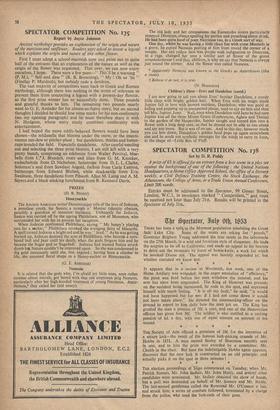SPECTATOR COMPETITION No. 175
Report by Joyce Johnson Ancient mythology provides an explanation of the origin and nature of the narcissus and sunflower. Readers were asked to invent a legend which explains the origin and nature of any other flower.
First I must adopt a school-marmish tone and point out to quite half of the entrants that an explanation of the nature as well as the origin of the flower was requested. That over, we can now enjoy ourselves, I hope. There were a few puns—" This'll be a warning " (P. M.), " Sell and dine " (R. B. Browning), " My ! Oh so 'tis " (Findlay P. Murdoch), but nobody rode a dendron.
The vast majority of competitors went back to Greek and Roman mythology, although there was nothing in the terms of reference to prevent them from concocting a legend with a present-day flavour, as the first prize winner has so successfully done. Three pounds and grateful thanks to him. The remaining two pounds nearly went to G. E. Assinder for his almost-as-funny story, but on second thoughts I decided he should lose some marks for his non-conformity (see my opening paragraph) and he must therefore share it with N. Hodgson, whose entry nicely combines conformity with entertainment.
I had hoped the more oddly-behaved flowers would have been chosen—the soldanella that blooms under the snow, or the insecti- vorous sun-dew or pitcher-plant • but dandelions, thistles and butter- cups invaded the field. Especially dandelions. After careful weeding out and selecting the three prize blooms, I am still left with a very pretty bunch, comprising an edelweiss from Walter Percival, blue- bells from C' J. Blundell, roses and lilies from G. M. Knocker, eschscholtzia from D. Nicholson, heliotrope from D. L. L. Clarke, Solomon's seal from Sawdust Asgold, fuchsia from Carla Lanyon, buttercups from Edward Blishen, white dead-nettle from Eric Swainson, three dandelions from Pibwob, Allan M. Laing and A. M. Sayers and a black stinking horehound from R. Kennard Davis.
PRIZES (D. R. PEDDY)
Honeysuckle The Ancient American write Demonrunjan tells of the love of Jodocus, a penniless youth, for Susicu, a nymph o' Maniac (identity obscure, possibly a guardian of innocent. maidens). Unhappily for Jodocus, Susicu was carried off by the ageing Philthiluca, son of Mammon, who surrounded her with Ice to prevent her recapture.
When Jodocils confronted Philthiluca, saying " My honey's playing you for a sucker," Philthiluca invoked the avenging deity of Macarthi. A spell turned Jodocus a bright red and he was " fired." As he was getting burned up, Jodocus damned the eyes of Philthiluca, who becante a com- bined bull and ,bear until his death, when the gods forgave him and he became the Sugar god or Sugadadi. Jodocus had wanted Susicu struck dumb bug Nature couldn't be improved upon. So she was condemned to dig gold incessantly until she, too, expired ; having been a climber in life, she assumed floral shape as a Honey-sucker or Honeysuckle.
(G. E. ASSINDER)
Nemesia It is related that the gods who, I'm afraid my little ones, were rather careless about morals, got bored with that old empyrean prig Nemesis, particularly after her high-handed treatment of young Narcissus. Antir- rhinum,* they called her (old nosey). The old lady and her companions the Eumenides sisters particularly annoyed Dionysus, always spoiling his parties and preaching about drink. He had been quite fond of poor Narcissus too, in a Greek sort of way.
One day, whilst he was having a little clean fun with some Maenads in a grove, he espied Nemesis peering at him from round the corner of a temple. Her old yellow face was purple with indignation so Dionysus, in a rage, changed her into a similar sort of flower of the genus seroplutlariaceaet,and that, children, is Why we say that Nemesis is always just round the corner. And the flower was called Nemesia.
* Apparently Nemesia was known to the Greeks as Antirrhinum (like a snout).
t Believe it or not, it is true.
(N. HODGSON)
Children's Hour—Eros and Dandelion (contd.)
I am now going to tell you about Eros' brother Dandelion, a sturdy little chap with bright, golden hair. When Eros with his magic made Jupiter fall in love with human maidens, Dandelion, who was good at hiding and popping up in unexpected places, used to spy on him and then tell Mrs. Jupiter, Juno. Well, once when Dandelion told Juno he had seen Jupiter kiss all the three Misses Grace (Euphrosyne, Aglaia and Thalia) in the garden of the Hesperides, Jupiter caught and turned him into a flower with a long deep root, so that he should not be able to run about and spy any more. But it was of no use. And to this day, however much you cut him down, Dandelion's golden head pops up again somewhere else and he sends out symbolic messages for the wiqsls to carry to Juno, in the shape of—Little Bits of Fluff.


































 Previous page
Previous page